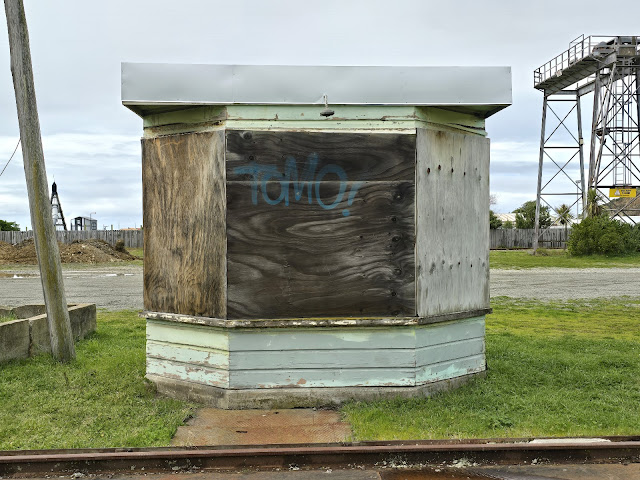The Oamaru weighbridge and cabin. 24/09/2024.
Oamaru has a good number of railway buildings that have escaped the bulldozers and excavators of past railway companies, the district council and from being torched by bored locals. One of these is the old weighbridge cabin located in the former goods yard. While the goods shed has gone on to bigger and brighter things as the home of Scotts Brewery, the old weighbridge cabin stands forlornly as the Oamaru Steam and Rail trains travel past nearby.
The location of the weighbridge in the old Oamaru goods yard.
Apart from the track, much of the old Oamaru goods yard infrastructure remains with the old weighbridge cabin located between the former goods shed and container gantry crane.
The New Zealand Railways installed weighbridges at most of their medium and large stations. The railways used the scales to find the weight of the load in a wagon so they could charge the right amount for transport. The weighbridges were also used to ensure wagons weren't overloaded, and to determine the weight of the wagon and its load so that trains could be put together that didn't exceed the tonnage limits of the locomotives hauling the trains.
To help staff work out the weight of the load, every wagon had the tare weight of the wagon and what it was capable of carrying called the distributed load stenciled on the side.
LA24158 with its tare and distributed weight stenciled on its side. This wagon is preserved and looked after by the Fielding and District Steam Rail Society. The weighbridge is made up of three parts, the weighbridge, the pit and the cabin.
The weighbridge and cabin in the old Oamaru goods yard. 14/09/2024.
Wagons were weighed using a mechanical system of levers. The weighbridge consisted of the rails which sat on two steel I beams that rested on the main levers located in the pit directly below. A transverse lever off the main lever connected to a rod that went up to either a sliding weigh beam or dial which showed the weight of the wagon and whatever it was carrying. Steel plates protected the levers from the elements and stopped people from falling into the pit. The weighbridge was only big enough for four wheel wagons.
The weighbridge and pit.
Weighbridge cabins were built to protect the scales and railway staff from the elements. The cabins came with large windows so that staff had a good view of the weighbridge and along the weighbridge siding.
The cabin is a standard NZR design that was used across the network. There were two versions of this type of weighbridge cabin. The first version was rectangular with windows at the front and two sides. The second version had windows at the front which angled to the sides like the one we have in Oamaru.
Front of the weighbridge cabin.
The rear of the weighbridge cabin.
The north side of the weighbridge cabin.
With the closure of the Oamaru goods yard and redevelopment of the land it is remarkable that the cabin and weighbridge still remain in situ. Hopefully the cabin continues as a reminder of the industrial and transport history of Oamaru and North Otago.
And that's about it.









No comments:
Post a Comment